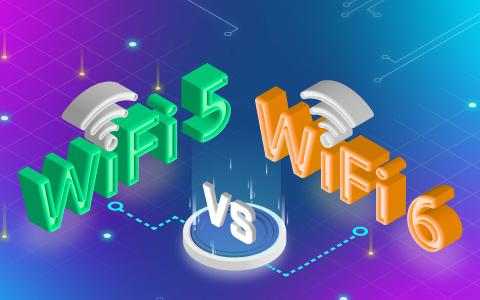WiFi 5 vs WiFi 6 - A Comprehensive Comparison
A reliable and high-speed Wi-Fi connection is essential in today age for a seamless online experience. As technology evolves, so does the Wi-Fi standard, with WiFi 5 and WiFi 6 being two of the most prominent options available. In this article, we will explore the key differences and advantages of WiFi 5 and WiFi 6, with a special focus on the Horizon Powered‘s HZ51 wireless router as a WiFi 6 device and its unique differentiation from other Horizon-powered products that primarily use WiFi 5 technology.

Let’s delve deeper into the features and characteristics of WiFi 5 (802.11ac) and WiFi 4 (802.11n) and see how it compares. Additionally, we will explore Horizon’s product lineup and how most of their devices powered by WiFi 5 technology.
WiFi 5 (802.11ac) Overview
WiFi 5, formally known as 802.11ac, represents a significant advancement in wireless technology. It succeeded WiFi 4 (802.11n) and brought a host of improvements that made it an attractive choice for consumers and businesses alike.
Speed and Range
WiFi 5 operates in the 5 GHz frequency band, which has several advantages over its predecessor, WiFi 4 that primarily utilized the 2.4 GHz band. One of the most notable benefits is speed. WiFi 5 provides a maximum theoretical data transfer rate of up to 3.46 Gbps, a considerable improvement over the maximum 600 Mbps offered by WiFi 4. This means that data can be transmitted at a significantly faster pace, enabling smoother streaming, faster downloads, and more responsive online experiences.
The 5 GHz frequency band offers reduced interference from other wireless devices like cordless phones and microwave ovens. This results in a more stable and reliable connection, especially in densely populated areas where multiple wireless networks might coexist.
WiFi 5 extends its range compared to WiFi 4, allowing users to enjoy a strong and consistent signal over more extensive areas. This makes it well-suited for larger homes, multi-story buildings, and office spaces, where coverage across a wide area is essential.
Horizon's Products Powered by WiFi 5
Horizon, a provider of networking and connectivity solutions, offers a range of products that are powered by WiFi 5 technology. These products are designed to provide solid and dependable performance across various applications, catering to the connectivity needs of both consumers and businesses.
Horizon’s WiFi 5-powered devices include routers, access points, and other networking equipment that leverage the advantages of the 802.11ac standard. They offer a combination of speed and range that meets the requirements of typical users, making them a reliable choice for those who need strong and stable wireless connections for everyday use for both consumers and businesses.
WiFi 5, represented by the 802.11ac standard, marked a significant leap in wireless technology with its enhanced speed and extended range, making it suitable for a wide range of applications. Horizon’s product lineup, consisting primarily of WiFi 5-powered devices, offers dependable connectivity solutions for various users. However, with the emergence of WiFi 6, users now have the opportunity to explore an even more advanced wireless standard with additional benefits for their networking needs.
While WiFi 5 represents a substantial step forward in wireless technology, the evolution of Wi-Fi continues with the introduction of WiFi 6 (802.11ax). WiFi 6 builds upon the foundation laid by WiFi 5 and offers even higher speeds, improved efficiency, and enhanced performance in crowded network environments. As a result, consumers and businesses now have the option to transition to WiFi 6 for even more advanced and future-proofed wireless connectivity solutions.
WiFi 6 (802.11ax) Overview
WiFi 6, or 802.11ax, stands as the latest and most advanced Wi-Fi standard in the wireless networking landscape. It represents a substantial leap forward compared to its predecessor, WiFi 5 (802.11ac), by introducing several groundbreaking features that significantly enhance wireless connectivity.
Speed and Efficiency
One of the most striking features of WiFi 6 is its exceptional speed and efficiency. With a maximum theoretical data transfer rate of up to 9.6 Gbps, WiFi 6 offers an impressive boost in speed over WiFi 5. This remarkable speed enables faster data transmission, reducing latency and ensuring an optimal experience for bandwidth-intensive activities like 4K video streaming, online gaming, and large file downloads.
Furthermore, WiFi 6 is designed to handle multiple devices simultaneously, making it especially well-suited for modern households and business environments where numerous devices are connected to the network. This capability is achieved through advanced technologies that allocate bandwidth more efficiently, ensuring a seamless online experience for everyone in the network.
Improved Range
WiFi 6 takes significant strides in improving range and coverage compared to its predecessor. This enhancement is achieved through innovative technologies such as Basic Service Set Coloring (BSS Coloring). BSS Coloring mitigates interference and enhances the reliability of connections by reducing signal collisions. This means that in areas with multiple overlapping wireless networks, WiFi 6 can maintain a strong and consistent signal, reducing the likelihood of dropouts and signal degradation.
The improved range is particularly beneficial for larger homes, offices, and spaces where maintaining robust Wi-Fi coverage across extended areas is crucial. It ensures that all devices within the network can access high-speed internet, even when they are located at a distance from the router.
MU-MIMO and OFDMA
Multi-User, Multiple-Input, Multiple-Output (MU-MIMO) and Orthogonal Frequency Division Multiple Access (OFDMA) are key technologies that define WiFi 6’s superiority. These technologies enable better distribution of data to multiple devices on the network, enhancing overall performance and reducing latency.
MU-MIMO allows the router to communicate with multiple devices simultaneously, ensuring that each device receives its share of the available bandwidth. This means that even in busy environments with many devices, there is a significant reduction in congestion and improved data transmission efficiency.
OFDMA, on the other hand, breaks down the wireless channel into smaller sub-channels, allowing multiple devices to transmit data simultaneously without causing interference. This results in a more efficient use of the available spectrum and further reduces latency.
Comparing WiFi 5 and WiFi 6
To make an informed decision between WiFi 5 (802.11ac) and WiFi 6 (802.11ax), it’s essential to examine the key aspects that differentiate these wireless standards.
Speed
One of the most prominent differences between WiFi 5 and WiFi 6 lies in their speed capabilities.
WiFi 6 offers significantly higher speeds compared to its predecessor, WiFi 5. With a maximum theoretical data transfer rate of up to 9.6 Gbps, WiFi 6 is designed to handle data-intensive tasks with ease. This makes it ideal for bandwidth-hungry applications such as 4K streaming, online gaming, and high-definition video conferencing. The increased speed ensures that multiple users can engage in data-intensive activities simultaneously without experiencing lag or buffering.
WiFi 5 introduced a substantial speed improvement over its predecessor, it offers a maximum theoretical data transfer rate of up to 3.46 Gbps. This is more than sufficient for most everyday internet tasks and can support streaming in high definition. However, it may not handle the demanding requirements of 4K streaming and multiple simultaneous data-heavy applications as efficiently as WiFi 6.
Coverage
The range and coverage of a wireless network are critical factors, particularly in larger homes and busy office environments.
WiFi 6 boasts improved range and coverage compared to WiFi 5, primarily due to innovative technologies like Basic Service Set Coloring (Basic Service Set (BSS) Coloring is a feature and technique used in WiFi 6 (802.11ax) to improve wireless network performance and reduce interference in crowded Wi-Fi environments. In a Wi-Fi network, a Basic Service Set (BSS) is a group of one or more access points (APs) and the associated client devices. Each BSS operates on a specific channel within the wireless spectrum to transmit data. However, in areas with many overlapping BSSs, such as a crowded office building or apartment complex, there can be interference and contention for the same frequency spectrum). These technologies help reduce interference and ensure a more reliable connection, even in environments with multiple overlapping wireless networks. This is a significant advantage for larger homes and busy office spaces, as it guarantees consistent and strong signal coverage throughout the premises.
WiFi 5 offers decent coverage, it may struggle in highly congested areas or environments with numerous wireless networks. The 5 GHz frequency band it operates in does provide better coverage than WiFi 4, but it may not be as effective as WiFi 6 in mitigating interference and maintaining a robust connection in challenging conditions.
Device Handling
The ability to handle multiple devices concurrently is crucial, especially in today’s world where households and workplaces are filled with a variety of smart devices.
WiFi 6 excels in device handling. Through technologies like Multi-User, Multiple-Input, Multiple-Output (MU-MIMO) and Orthogonal Frequency Division Multiple Access (OFDMA), WiFi 6 can efficiently distribute data to multiple devices, ensuring that each device receives its share of the available bandwidth. This is particularly advantageous in households with numerous smart devices, as it minimizes network congestion and ensures a seamless online experience for all users.
WiFi 5 also supports MU-MIMO, it may not be as efficient in handling multiple devices as WiFi 6. In congested network scenarios, WiFi 5 may experience performance degradation as the number of connected devices increases. This could result in slower data transfer rates and potential network congestion.
Horizon HZ51 - A WiFi 6 Device
The Horizon HZ51 represents the pinnacle of wireless networking technology as a WiFi 6 router. This state-of-the-art router harnesses the full potential of the WiFi 6 standard, offering a range of advanced features and capabilities that elevate the wireless experience for users.
One of the standout features of the Horizon HZ51 is its remarkable coverage and performance. Whether you’re in a large home, a multi-story building, or a busy office environment, this router provides exceptional coverage, ensuring that every corner of the space enjoys a strong and consistent Wi-Fi signal. This is especially advantageous in environments with numerous connected devices, as the HZ51’s advanced technologies can efficiently manage data distribution, ensuring that each device experiences optimal performance.
The router’s speed and efficiency are also commendable. With a maximum theoretical data transfer rate of up to 9.6 Gbps, the HZ51 can handle bandwidth-intensive tasks with ease. Whether it’s 4K streaming, online gaming, or high-definition video conferencing, this router ensures a lag-free and uninterrupted experience, even when multiple users are engaging in data-heavy activities simultaneously.

Differentiation: Other Horizon-Powered Products Using WiFi 5
It’s crucial to highlight a significant differentiation between the Horizon HZ51 and other Horizon-powered products. While the HZ51 embraces the cutting-edge WiFi 6 technology, the majority of Horizon’s product lineup relies on WiFi 5 (802.11ac). This distinction is essential for users seeking the advantages of WiFi 6 and a high-performance wireless solution.
WiFi 6 represents the latest and most advanced Wi-Fi standard, designed to meet the demands of modern households and businesses where the number of connected devices is ever-increasing. By choosing the Horizon HZ51, users can access the enhanced capabilities of WiFi 6, which include faster speeds, improved coverage, and more efficient handling of multiple devices. This forward-looking approach ensures that users are well-prepared for the increasing demands of their wireless networks.
In contrast, Horizon’s other WiFi 5-powered products remain robust and reliable options for various applications. WiFi 5 provides excellent performance and coverage for most everyday tasks, making it a practical choice for users who may not require the advanced features of WiFi 6.
The Horizon HZ51’s adoption of WiFi 6 technology places it in a league of its own, offering exceptional coverage, speed, and device management capabilities. This differentiation from other Horizon-powered products utilizing WiFi 5 highlights the HZ51’s forward-looking approach and its appeal to users who seek the advantages of WiFi 6 for a superior wireless experience in an increasingly connected world.
Conclusion
In the ever-evolving world of wireless technology, the decision between WiFi 5 and WiFi 6 hinges on your specific requirements and financial considerations. Both standards have their merits, and making an informed choice ensures that your network meets your needs effectively.
WiFi 5 remains a valid option for many users, offering solid performance and coverage for everyday connectivity needs. Its widespread availability in networking equipment makes it an accessible and reliable choice. It can deliver a stable online experience for most tasks, including web browsing, email, and video streaming, making it a practical choice for homes and businesses.
However, the emergence of WiFi 6 introduces a more advanced and forward-looking solution. Devices like the Horizon HZ51 router exemplify the capabilities of WiFi 6. These routers offer a range of significant advantages, including higher speeds, improved coverage, and efficient handling of multiple devices. These features are particularly valuable in environments where the number of connected devices is increasing, such as modern households and busy offices.
The differentiation of the Horizon HZ51 as a WiFi 6 device within the Horizon product lineup is worth highlighting. While most other Horizon-powered products primarily rely on WiFi 5, the HZ51’s embrace of WiFi 6 showcases a commitment to providing a high-performance, future-ready solution. It stands out as a choice for those who seek to fully leverage the capabilities of WiFi 6 for enhanced wireless performance.
As the demand for faster and more reliable Wi-Fi continues to surge, investing in WiFi 6 technology, such as the Horizon HZ51 router, is a prudent move. This investment promises to bring a significant improvement in your wireless network’s coverage and performance, ensuring a seamless and responsive online experience in an era where connectivity plays an ever-expanding role in our daily lives.
The choice between WiFi 5 and WiFi 6 ultimately comes down to your specific needs and aspirations. While WiFi 5 is tried and tested, WiFi 6, represented by the Horizon HZ51 and similar devices, provides a glimpse into the future of wireless connectivity, offering an upgraded and advanced experience that aligns with the growing demands of our connected world.








